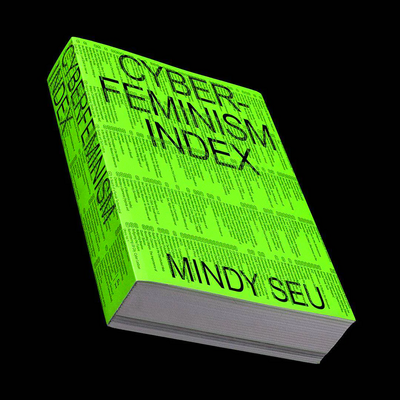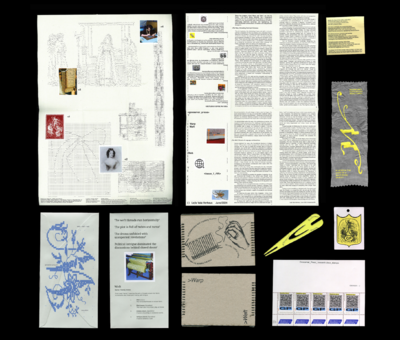[002]
Cyberfeminism Index
Individual
critical

Cyberfeminism Index by Mindy Seu
In Cyberfeminism Index, hackers, scholars, artists, and activists of all regions, races and sexual orientations consider how humans might reconstruct themselves by way of technology. When learning about internet history, we are taught to focus on engineering, the military-industrial complex, and the grandfathers who created the architecture and protocol, but the internet is not only a network of cables, servers, and computers. It is an environment that shapes and is shaped by its inhabitants and their use.
The creation and use of the Cyberfeminism Index is a social and political act. It takes the name cyberfeminism as an umbrella, complicates it, and pushes it into plain sight. Edited by designer, professor, and researcher Mindy Seu, it includes more than 700 short entries of radical techno-critical activism in a variety of media, including excerpts from academic articles and scholarly texts; descriptions of hackerspaces, digital rights activist groups, and bio-hacktivism; and depictions of feminist net art and new media art.
Both a vital introduction for laypeople and a robust resource guide for educators, Cyberfeminism Index—an anti-canon, of sorts—celebrates the multiplicity of practices that fall under this imperfect categorization and makes visible cyberfeminism’s long-ignored origins and its expansive legacy.
“the Cyberfeminism Index is incomplete and always in progress..”
07.01.26
[007]
Zeros and Ones: Digital Women and the New Technoculture
Individual
critical
Zeros and Ones is an investigation of the intersection between women, feminism, machines and in particular, information technology. Arguing that the computer is rewriting the old conceptions of man and his world, it suggests that the telecoms revolution is also a sexual revolution which undermines the fundamental assumptions crucial to patriarchal culture. Historical, contemporary and future developments in telecommunications and in IT are interwoven with the past, present and future of feminism, women and sexual difference, and a wealth of connections, parallels and affinities between machines and women are uncovered as a result. Challenging the belief that man was ever in control of either his own agency, the planet, or his machines, this book argues it is seriously undermined by the new scientific paradigms emergent from theories of chaos, complexity and connectionism, all of which suggest that the old distinctions between man, woman, nature and technology need to be radically reassessed.
07.01.26
[013]
A Traversal Network of Feminist Servers
Collective
social
A Traversal Network of Feminist Servers is a collaborative project formed around intersectional, feminist, ecological servers whose communities travel between each other to share and extend their skills through live gatherings. Such platforms and tools are necessary to navigate our communications and cultural growth beyond the current media oligopolies and democratize cultural and political expression outside obscure algorithms and advertising monetization. The project is documented through a mobile server and a print publication, each chapter being shaped by a partner.
07.01.26
[024]
Our Bodies, Online
Individual
social
What are the qualifications of being a feminist artist today? This is an impossible question, which is, in many ways, the point. One of the defining doctrines of third-wave feminism (or fourth-wave feminism, or postfeminism, or whatever you call our current moment) is its persistent unwillingness to be defined. Whether you make abstract photograms or stag films, label your work feminist, and it is.
“An emerging guard of young, female photographers has carved out a new brand of feminism
with a new set of definitions.”
07.01.26
[026]
“Trust Us, We’re You”: Aspirational Realness in the Digital Communication of Contemporary Fashion and Beauty Brands
Individual
critical
In recent years, a number of fashion and beauty brands have developed promotional content that circulates an aspirational quality imbued with unstudied “cool” around their product. Despite the appeal of this conceit to tropes of the everyday, authenticity, and belonging, it presents a superficially relatable ideal whilst exploiting digital media’s capacities to foster intimacy and promote a postfeminist subjectivity based on consumption.
This article examines three brands that circulate “aspirational realness” around their product: Glossier, Reformation, and Maryam Nassir Zadeh. All remediate the conventions of prior fashion media to communicate discourses of neoliberal femininity to a media-savvy consumer. Aspirational realness is thus read as a means by which consumption is both encouraged and situated as a means of self-realization in the likeness of other aspirational “cool girls.”
07.01.26
[029]
Girl Online: A User Manual
Individual
social
What happens when a woman goes online? She becomes a girl.
The unwritten contract of the internet, that a user is what is used, extends from the well-examined issue of data privacy and consent to the very selves women are encouraged to create in order to appear. Invited to self-construct as 'girls online', vloggers, bloggers and influencers sign a devil's bargain: a platform on the condition they commodify themselves, eternally youthful, cute and responsibility-free, hiding offline domestic, professional and emotional labour while paying for their online presence with ‘accounts’ of personal ‘experience’. Can a Girl Online use these platforms not only to escape meatspace oppressions, but as spaces for survival, creativity and resistance?
Told via the arresting personal narrative of one woman negotiating the (cyber)space between her identities as girl, mother, writer, and commodified online persona, Girl Online is written in a plethora of the online styles, from programming language to the blog/diary, from tweets to lyric prose, taking in selfies, social media, celebrity and Cyberfeminism.
07.01.26
[032]
Glitch Feminism: A Manifesto
Individual
critical
A new manifesto in cyberfeminism: finding liberation in the glitch between body, gender and technology.
The divide between the digital and the real world no longer exists: we are connected all the time. How do we find out who we are within this digital era? Where do we create the space to explore our identity? How can we come together and create solidarity?
The glitch is often dismissed as an error, a faulty overlaying, but, as Legacy Russell shows, liberation can be found within the fissures between gender, technology and the body that it creates. The glitch offers the opportunity for us to perform and transform ourselves in an infinite variety of identities. In Glitch Feminism, Russell makes a series of radical demands through memoir, art and critical theory, and the work of contemporary artists who have travelled through the glitch in their work. Glitch Feminism shows how the error can be a revolution.
“Within glitch feminism, glitch is celebrated as a vehicle of refusal, a strategy of nonperformance.”
07.01.26
[034]
Seduced & Abandoned: The Body in the Virtual World - The Feminine Cyberspace
Individual
critical
Sadie Plant argues that cyberspace is a potentially radical space which uses modes of thinking and operating that have traditionally been seen as female. She also considers the relationship between cyberspace and immaterial space and speculates on what this could mean for the future. Christine Tamblyn and Pat Cadigan contribute to the discussion/Q&A, which makes for a lively discourse on the females positioning in technoculture.
07.01.26
[036]
GIRLSTACK
Individual
speculative

image by siir bicer
Building on the ideas of Tiqqun’s 1999 anti-neoliberal treatise Preliminary Materials for a Theory of the Young-Girl, Andrea Long Chu’s Females and Bogna Konior’s work on the girl and the inhuman vis-a-vis the machinic, Quicho has developed a concept she calls the “Girlstack,” which, to borrow her words, models the “ultrasmooth, cybergothic, and angelic dimensions of the girl’s natural habitat.” Quicho articulates how the ‘girl’ inhabits no one person, body, or gender. She is a technology of subjectivity composed of symbolic, consumer, and inhuman elements and might be our only way out of the platform trap. Quicho's reformulation of 'the stack' was first published as an essay on Wired and expanded at BODYSTACK and Creamcake 3HD.
Quicho’s girl-stack is a speculative prototype models themany dimensions of the girl’s natural online habitat. To be clear: Quicho does not speak of actual girls or the experience of lived girlhood, but a socially constructed ideation of the girl. So, the girl as a vehicle for selling product, the girl as a tool for manipulating entrenched power, the girl as living currency, and the girl as desiring machine. The model is imperative for understanding the environment that produces the ‘girl as condition’.
07.01.26
[041]
I'm Like a PDF but a Girl
Individual
pedagogy
A literary and ethnographic analysis of the Tumblr platform, supplemented by personal experiences, to explore the site's potency as a pedagogical tool. Ester Freider explains.. "I'm Like a Pdf but a Girl originates from my usage of tumblr as a social learning platform during high school, when AFK I had little educational resources surrounding feminist studies, philosophy, and potential leftisms in my high school and so, turned to a network of peers online to educate myself."
“Embrace subjectivity. Nomadologize. Unclog digital neuroses. Reconnect with the ancients. Atomize. Overflow with information. Make love piratic. Plagiarize with the girls. Weave webs of excess. Become a girlblogger.”
07.01.26
[049]
Performing Cyber Tenderness
Individual
social
This text discusses the concept of the "Sad Girl" and its evolution in the digital age. It explores how the internet, particularly platforms like Tumblr, became a space for young women to express their emotions, often through romanticized depictions of sadness and melancholy. The text examines the authenticity and commodification of these emotional performances, as well as the broader societal expectations and pressures placed on women's emotional expression. It also touches on the concept of the "Influencer" and how the pursuit of authenticity has become a tool for capitalist exploitation. The document ultimately suggests that embracing the "Cyborg" and the performative nature of online identity may be a way to resist the commodification of emotion and reclaim digital spaces.
““As you gaze at the flickering signifiers scrolling down the computer screens, (…) you have already become posthuman.””
07.01.26
[052]
Xenofeminism
Academia
speculative
In an era of accelerating technology and increasing complexity, how should we reimagine the emancipatory potential of feminism? How should gender politics be reconfigured in a world being transformed by automation, globalization and the digital revolution?
These questions are addressed in this bold new book by Helen Hester, a founding member of the ‘Laboria Cuboniks’ collective that developed the acclaimed manifesto ‘Xenofeminism: A Politics for Alienation’. Hester develops a three-part definition of xenofeminism grounded in the ideas of technomaterialism, anti-naturalism, and gender abolitionism. She elaborates these ideas in relation to assistive reproductive technologies and interrogates the relationship between reproduction and futurity, while steering clear of a problematic anti-natalism. Finally, she examines what xenofeminist technologies might look like in practice, using the history of one specific device to argue for a future-oriented gender politics that can facilitate alternative models of reproduction.
07.01.26
[059]
Autotheory as Feminist Practice in Art, Writing and Criticism
Individual
critical
In the 2010s, the term “autotheory” began to trend in literary spheres, where it was used to describe books in which memoir and autobiography fused with theory and philosophy. In this book, Lauren Fournier extends the meaning of the term, applying it to other disciplines and practices. Fournier provides a long-awaited account of autotheory, situating it as a mode of contemporary, post-1960s artistic practice that is indebted to feminist writing, art, and activism. Investigating a series of works by writers and artists including Chris Kraus and Adrian Piper, she considers the politics, aesthetics, and ethics of autotheory.
Fournier argues that the autotheoretical turn signals the tenuousness of illusory separations between art and life, theory and practice, work and the self—divisions long blurred by feminist artists and scholars. Autotheory challenges dominant approaches to philosophizing and theorizing while enabling new ways for artists and writers to reflect on their lives. She argues that Kraus's 1997 I Love Dick marked the emergence of a newly performative, post-memoir “I”; recasts Piper's 1971 performance work Food for the Spirit as autotheory; considers autotheory as critique; examines practices of citation in autotheoretical work, including Maggie Nelson's The Argonauts; and looks at the aesthetics and ethics of disclosure and exposure, exploring the nuanced feminist politics around autotheoretical practices and such movements as #MeToo. Fournier formulates autotheory as a reflexive movement, connecting thinking, making art, living, and theorizing.
“Autotheory—the commingling of theory and philosophy with autobiography—as a mode of critical artistic practice indebted to feminist writing and activism.”
07.01.26
[061]
Gossamer Press
Individual
autonomous

Gossamer Press by Lejla Vala Verheus
Gossamer Press, a micro-publishing platform, intertwines female-driven textile crafts with digital realms, adopting annon-linear approach akin to navigating a web. Exploring concepts like 'Warp,' 'Weft,' and 'Gap,' it connects physical and digital realms, uncovering hidden narratives and challenging historical erasure, presenting a dynamic view of interconnected webs.
GP is founded by Lejla Vala Verheus and is part of an ongoing research on open-source methodologies in textile craft and the digital realm, drawing upon her background as a critical fashion practitioner and graphic designer. By rediscovering overlooked codes and relationships, questioning traditional publishing methods, and blending fashion with printed media, Lejla aims to create new narratives in the fashion realm.
07.01.26
[071]
Memestrilism
Individual
critical
Memestrilism is a term made up of "meme" and "minstrelsy" used to describe minstrel-like behaviours, trends and creations in digital spaces. Produced by artist Ama Ogwo as part of the first Feminist Internet Residency, the film critically examines how racism persists in the digital age, paralleling contemporary online representations of blackness with historical racist imagery. Using found footage from social media and 20th-century minstrel shows, Ogwo collapses time to reveal how the ventriloquism of blackness online mirrors and reinvents what minstrelsy looks like today.
The concept of Memestrilism offers a critical lens on the current online zeitgeist, particularly in fashion, by highlighting how cultural appropriation and racial stereotyping continue to manifest in digital spaces. In fashion, the commodification of black culture often intersects with the 'meme economy' of social media, where trends are amplified, decontextualised and stripped of their origins for mass consumption.
The digital landscape thrives on 'hypervisibility', where cultural markers are presented as bold statements, but often lack the necessary cultural nuance. Often Black cultural expressions - hairstyles, clothing styles, linguistic expressions and aesthetics - are showcased through influencers or memes that gain widespread appeal, often without reference to their roots. This parallels historical minstrelsy, where black identity was caricatured and exploited for entertainment. The digital age exacerbates this by enabling the rapid dissemination and monetisation of these trends, further blurring the line between homage and exploitation.
Ogwo's exploration of memestrilism not only critiques, but also reflects the larger conversations taking place in digital fashion spaces about authenticity, representation and the ethics of appropriation in a globalised, meme-driven culture.
07.01.26
[082]
A feminist server stack: co-designing feminist web servers to reimagine Internet futures
critical
This paper explores the idea of a "feminist server stack," which challenges traditional, centralized internet infrastructure by proposing alternative, community-driven digital spaces. It draws from feminist principles to rethink how digital tools and networks are designed, governed, and used—prioritizing care, consent, and collective control over data. The paper critiques dominant, profit-driven tech ecosystems and imagines new ways of structuring servers, storage, and communication that align with ethical and inclusive values. Ultimately, it advocates for a reimagined digital landscape where technology empowers marginalized voices and fosters more equitable, decentralized, and self-sustaining digital communities.
In reimagining servers as sites of care, A Feminist Server Stack enacts affirmative ethics by centering consent, maintenance, and relationality within digital infrastructure. Through co-design, it resists extractive norms and proposes a situated, collective stack that foregrounds the politics of hosting—where serving becomes an act of feminist world-building.
07.01.26
[087]
Creating Feminist Paths with Mood Boards
Individual
pedagogy
In Creating Feminist Paths with Mood Boards, Floriane Fo Misslin opens up a path toward an intersectional feminist citational practice for visual references. The essay rethinks mood boards—often dismissed as simple inspiration tools—as sites for thoughtful and politically engaged feminist work. Misslin shows how they can map connections, surface overlooked voices, and challenge dominant narratives in design and education. Through intentional curation, mood boards become spaces for reflection, citation, and imagination—offering ways to practice solidarity, build collective knowledge, and foster more inclusive and critical modes of working, especially in creative and pedagogical contexts.
Misslin’s feminist expansion of the mood board as a citational tool is a much-needed intervention in fashion, where visual referencing often goes unacknowledged or uncredited. The work draws urgent attention to how inspiration circulates—and how it might be redirected toward more ethical, inclusive, and reflexive practices. In a field that frequently celebrates aesthetics without interrogating power, this approach offers a critical perspective on citation as both visual and political. It urges fashion practitioners to trace their influences with care and to reimagine how knowledge is shared.
“Where does authorship begin? Is a bibliography—or a set of visual references—intellectual property?”
07.01.26


